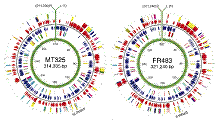Virology, Nebraska Center for
Document Type
Article
Date of this Version
12-2005
Abstract
AIDS associated malignancies (ARL) is a major complication associated with AIDS patients upon immunosuppression. Chronically immunocompromised patients have a markedly increased risk of developing lymphoproliferative disease. In the era of potent antiretrovirals therapy (ARV), the malignant complications due to HIV-I infection have decreased in developed nations where ARV is administered, but still poses a major problem in developing countries where HIV-l incidence is high and ARV is still not yet widely available. Even in ARV treated individuals there is a concern that the prolonged survival of many HIV-l carriers is likely to eventually result in an increased number of malignancies diagnosed. Malignancies that were found to have high incidence in HIV-infected individuals are Kaposi's sarcoma (KS), Hodgkin's disease (HD) and non-Hodgkin's lymphoma (NHL). The incidence of NHL has increased nearly 200 fold in HIV-positive patients, and accounts for a greater percentage of AIDS defining illness in the US and Europe since the advent of HAART therapy. These AIDS related lymphomas are distinct from their counterparts seen in HIV-l seronegative patients. For example nearly half of all cases of ARL are associated with the presence of a gamma herpesvirus, Epstein Barr virus (EBV) or human herpesvirus-8 (HHV-8)/ Kaposi's sarcoma associated herpesvirus (KSHV). The pathogenesis of ARLs is complex. B-cell proliferation driven by chronic antigenemia resulting in the induction of polyclonal and ultimately monoclonal lymphoproliferation may occur in the setting of severe immunosuppression.



Comments
Published in Cell Research, 15(11-12):947-952, Nov-Dec 2005. Copyright 2005. Used by permission.